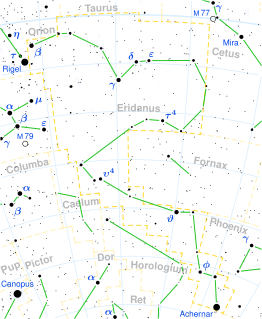
HD 12661 is a G-type main sequence star in the northern constellation of Aries. The star is slightly larger and more massive than the Sun, with an estimated age of seven billion years. It has two known extrasolar planets.
HD 114783 is an 8th magnitude star about 68.7 light years away in the constellation of Virgo. As an orange dwarf it is somewhat dimmer and cooler than our Sun. The spectral type of the star is K0V. The star is not visible with the unaided eye, but is easy target for binoculars.

HD 10647 is a 6th-magnitude yellow-white dwarf star, 57 light-years away in the constellation of Eridanus. The star is visible to the unaided eye under very dark skies. It is slightly hotter and more luminous than the Sun, and at 1,750 million years old, it is also younger. An extrasolar planet was discovered orbiting this star in 2003.
HD 38529 is a binary star approximately 138 light-years away in the constellation of Orion.
HD 40979 is a triple star system in the northern constellation of Auriga. The combined brightness of this group lies below the typical limit of visibility to the naked eye at an apparent visual magnitude of 6.74. It is located at a distance of approximately 108 light years from the Sun based on parallax. The system is receding with a radial velocity of +32 km/s. It has a relatively high rate of proper motion, traversing the celestial sphere at the rate of 0.182″ per year.
HD 217107 b is an extrasolar planet approximately 65 light-years away from Earth in the constellation of Pisces. The planet was discovered orbiting the star HD 217107 approximately every seven days, classifying the planet as a hot Jupiter. Because of the planet's somewhat eccentric orbit, scientists were able to confirm another planet within the system.
HD 11964 b is an extrasolar planet, a gas giant like Jupiter approximately 110 light-years away in the constellation of Cetus. The planet orbits the yellow subgiant star HD 11964 in a nearly-circular orbit, taking over 5 years to complete a revolution around the star at a distance of 3.34 astronomical units.

79 Ceti b is an extrasolar planet orbiting its star every 75 days. With HD 46375 b on March 29, 2000, it was the joint first known extrasolar planet to have minimum mass less than the mass of Saturn.
HD 2039 b is an extrasolar planet orbiting the star HD 2039. It is almost five times as massive as Jupiter and has a very eccentric orbit.
HD 178911 is a triple star system in the constellation Lyra. The secondary star has an apparent magnitude of 6.74 and a spectral type of G1V, which is very similar to our Sun at a distance of 160 light years. The age of the star is slightly older and have significantly higher metallicity than our Sun.
HIP 14810 b is a massive hot Jupiter approximately 165 light-years away in the constellation of Aries. It has mass 3.88 times that of Jupiter and orbits at 0.0692 AU. It was discovered by the N2K Consortium in 2006 and the discovery paper was published in 2007. Prior to this a preliminary orbit had been published in the Catalog of Nearby Exoplanets.
HD 117618 b, named Noifasui by the IAU, is an exoplanet discovered orbiting the star HD 117618 in September 2004. The planet is a small gas giant less than a fifth the mass of Jupiter. It orbits close to its star in a very eccentric orbit.
HD 117207 b is an extrasolar planet orbiting at 3.79 astronomical units taking about 2597 days to complete its orbit around HD 117207. Its orbit is moderate in eccentricity. This planet was announced in January 2005 by Marcy in Keck Observatory. The planet has at least 1.88 Jupiter masses.
HD 114783 b is an exoplanet that has a minimum mass almost exactly that of Jupiter. However, since the true mass is not known, it may be more massive, but not likely much. It orbits the star 20% further than Earth orbits the Sun. The orbit is quite circular.
HD 188015 b is an extrasolar planet announced by the California and Carnegie Planet Search team in 2005. Like majority of known planets, it was discovered using the radial velocity method.
HD 210277 b is an extrasolar planet orbiting the star HD 210277. It was discovered in September 1998 by the California and Carnegie Planet Search team using the highly successful radial velocity method. The planet is at least 24% more massive than Jupiter. The mean distance of the planet from the star is slightly more than Earth's distance from the Sun. However, the orbit is very eccentric, so at periastron this distance is almost halved, and at apastron it is as distant as Mars is from the Sun.
HD 40979 b is an extrasolar planet orbiting the star HD 40979, was detected from the Lick and Keck observatories and photometric observations at Fairborn Observatory reveal low-amplitude brightness variations in HD 40979. It is thought to be a large gas giant planet. It was discovered in 2002 by Debra Fischer.
HD 50554 b is a Jupiter-sized extrasolar planet with minimum mass 4.4 times that of Jupiter. The planet was announced in 2001 by the European Southern Observatory and confirmed in 2002 using observations from the Lick and Keck telescopes.
HD 92788 b is an exoplanet located approximately 113 light-years away in the constellation of Sextans, orbiting the star HD 92788. The semimajor axis of this 3.68 Jupiter mass planet is 0.97 astronomical units, taking approximately 326 days to revolve.
HD 68988 c is an exoplanet located approximately 192 light-years away in the constellation of Ursa Major, orbiting the star HD 68988. The parameters including period and eccentricity are highly uncertain. The semimajor axis would be 5.32 AU with an orbital period of 4100 ± 7300 days.



